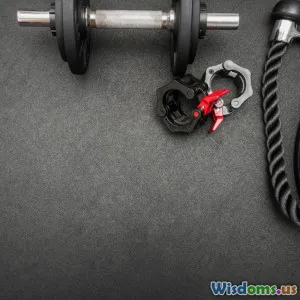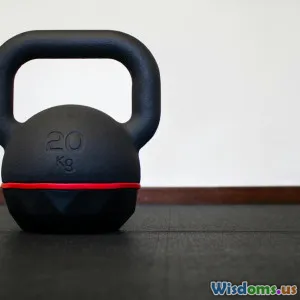
Metabolic Conditioning Explained The Secret to Faster Fat Loss
10 min read Discover how metabolic conditioning accelerates fat loss through efficient, science-backed workouts. (0 Reviews)
Metabolic Conditioning Explained: The Secret to Faster Fat Loss
When it comes to fat loss, it’s not just about cutting calories or long hours on a treadmill. What if the key to shedding fat faster lies in how you train your metabolism? Enter metabolic conditioning (metcon) — a high-energy workout approach designed to prime your body for accelerated fat loss while improving endurance and strength.
In this detailed dive, we'll unravel what metabolic conditioning is, why it’s so effective for fat loss, how it works from a physiological perspective, and how you can incorporate it into your routine for maximum results.
What is Metabolic Conditioning?
Metabolic conditioning refers to workouts specifically crafted to enhance the efficiency of the aerobic and anaerobic energy systems your body uses. Simply put, it’s about training your metabolism to burn energy quickly and effectively by combining high-intensity efforts with brief rest periods.
Unlike traditional steady-state cardio, metcon workouts push your heart rate to near maximum repeatedly, leveraging exercises such as burpees, kettlebell swings, sprints, or battle ropes in circuits or interval formats.
For example, the popular CrossFit Workout of the Day (WOD), “Fran,” which is 21-15-9 reps of thrusters and pull-ups, exemplifies metabolic conditioning by demanding strength, power, and cardiovascular fitness all at once.
Why Metabolic Conditioning is a Game Changer for Fat Loss
1. Boosts Excess Post-Exercise Oxygen Consumption (EPOC)
A standout benefit of metabolic conditioning is its ability to trigger EPOC, commonly known as the “afterburn effect.” Research indicates that following high-intensity workouts, your body continues to consume oxygen at an elevated rate, thereby burning more calories even at rest.
For example, a 2016 study in the Journal of Strength and Conditioning Research showed that high-intensity interval training (HIIT), a form of metcon, increased post-exercise caloric burn by approximately 15-20% for several hours after exercise.
2. Engages Multiple Energy Systems Simultaneously
Rather than focusing on either aerobic (slow-burning, oxygen-dependent) or anaerobic (short-burst, oxygen-independent) systems separately, metabolic conditioning targets both. This dynamic approach leads to improved fat oxidation, endurance, and muscular power.
3. Time-Efficient and High-Impact
Traditional cardio sessions often demand 45+ minutes to be effective for fat loss. Metabolic conditioning workouts can produce comparable or superior fat oxidation in 20-30 minutes due to their intensity, making them perfect for busy schedules.
4. Improves Overall Fitness
Aside from fat loss, metcon improves cardiovascular capacity, muscular endurance, agility, and even mental toughness. This holistic improvement means your body becomes more efficient at burning calories in daily life as well.
The Science Behind Metabolic Conditioning and Fat Loss
At the core of fat loss is energy balance — calories in versus calories out. Metabolic conditioning influences the “calories out” part by maximizing your energy expenditure and metabolic rate.
Energy Systems Explained
Your muscles get energy from three primary systems:
- Phosphagen System: Immediate energy supply from stored ATP and creatine phosphate, working for around 10 seconds.
- Glycolytic System: Anaerobic pathway that breaks down glucose to produce ATP rapidly, lasting about 30 seconds to 2 minutes.
- Oxidative System: Aerobic pathway utilizing oxygen to break down fats and carbs for sustained energy.
Metabolic conditioning efficiently trains your body to switch smoothly between these systems, particularly by featuring short bursts (phosphagen and glycolytic systems) followed by recovery, and enhancing aerobic capacity.
Hormonal Impact
High-intensity exercise stimulates the release of fat-burning hormones such as adrenaline and growth hormone. Studies have found that these hormones increase lipolysis — the breakdown of fat stores — making fat more readily available for energy use.
A 2015 review in the European Journal of Applied Physiology concluded that intense interval training induces greater lipolytic hormone release compared to steady-state exercise.
Designing Your Metabolic Conditioning Workout
The beauty of metabolic conditioning is its flexibility. Here are foundational principles and examples to help you build effective fat-burning sessions:
Work-to-Rest Ratios
A common pattern is intense exercise for 20-40 seconds followed by 10-20 seconds rest (Tabata style), or circuits of 30-45 seconds work with 15-30 seconds rest.
Movement Selection
Compound movements that recruit large muscle groups yield the best results:
- Burpees
- Kettlebell Swings
- Jump Squats
- Push-ups
- Mountain Climbers
Sample Workout:
| Exercise | Duration | Rest | Rounds |
|---|---|---|---|
| Kettlebell Swings | 30 sec | 15 sec | 5 |
| Burpees | 30 sec | 15 sec | 5 |
| Jump Lunges | 30 sec | 15 sec | 5 |
| Push-ups | 30 sec | 15 sec | 5 |
This 20-minute routine burns calories intensely during and after completion due to EPOC.
Progress Tracking
Monitor improvements via performance (more reps per interval), reduced rest time, or physiological markers like heart rate recovery. Tracking motivates adherence and helps gauge fat loss efficacy over weeks.
Real-World Insights and Considerations
Expert Opinions
Dr. Martin Gibala, a pioneer in interval training research at McMaster University, notes, “Short bursts of intense exercise yield benefits that match or exceed traditional cardio, especially for fat loss and metabolic health.”
Who Should Try Metcon?
Metabolic conditioning can suit beginners with scaled versions but is especially effective for intermediate to advanced trainees who want to break plateaus and boost metabolic rate.
Cautions
High-intensity workouts demand adequate recovery and should consider individual fitness levels and any medical conditions. Overtraining can lead to fatigue and injury.
Conclusion: Take the Leap Towards Smarter Fat Loss
Metabolic conditioning isn’t just a trendy buzzword — it’s a scientifically backed method that optimizes how your body burns fat and improves fitness efficiently. By targeting multiple energy systems, supercharging your metabolism through EPOC, and incorporating compound movements and strategic work-rest intervals, you can accelerate fat loss and transform your health.
If your goal is to lose fat faster and get fitter in less time, integrating metabolic conditioning workouts into your exercise regime offers a practical, time-conscious, and powerful solution. Start with manageable sessions, progressively increase intensity and complexity, and watch as your metabolism shifts into high gear.
Remember, the secret to lasting fat loss lies in smarter training — and metabolic conditioning is your key.
References:
- Gibala, M.J., et al. (2012). Physiological adaptations to low-volume, high-intensity interval training in health and disease. The Journal of Physiology.
- Boutcher, S.H. (2011). High-intensity intermittent exercise and fat loss. Journal of Obesity.
- Alkahtani, S.A., et al. (2016). Effects of high intensity interval and continuous moderate intensity training on aerobic and anaerobic capacity. Journal of Strength and Conditioning Research.
- Egan, B., & Zierath, J.R. (2013). Exercise metabolism and the molecular regulation of skeletal muscle adaptation. Cell Metabolism.
Rate the Post
User Reviews
Popular Posts





















